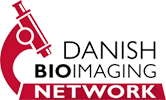Frontpage › Forums › Techniques › How To Characterize Individual Nanosize Liposomes with Fluorescence Microscopy
- This topic has 0 replies, 1 voice, and was last updated 5 years, 7 months ago by
 Henrik Flyvbjerg.
Henrik Flyvbjerg.
-
AuthorPosts
-
September 18, 2018 at 4:31 pm #2781
 Henrik FlyvbjergParticipant
Henrik FlyvbjergParticipantABSTRACT: Nanosize lipid vesicles are used extensively at the interface between nanotechnology and biology, e.g., as containers for chemical reactions at minute concentrations and vehicles for targeted delivery of pharmaceuticals.
Typically, vesicle samples are heterogeneous as regards vesicle size and structural properties. Consequently, vesicles must be characterized individually to ensure correct interpretation of experimental results. Here we do that using
dual-color fluorescence labeling of vesicles—of their lipid bilayers and lumens, separately. A vesicle then images as two spots, one in each color channel. A simple image analysis determines the total intensity and width of each spot. These four data all depend on the vesicle radius in a simple manner for vesicles that are spherical, unilamellar, and optimal encapsulators of molecular cargo. This permits identification of such ideal vesicles. They in turn enable calibration of the dual-color fluorescence microscopy images they appear in. Since this calibration is not a separate experiment but an analysis of images of vesicles to be characterized, it eliminates the potential source of error that a separate calibration experiment would have been. Nonideal vesicles in the same images were characterized by how their four data violate the calibrated relationship established for ideal vesicles. In this way, our method yields size, shape, lamellarity, and encapsulation efficiency of each imaged vesicle. Applying this procedure to extruded samples of vesicles, we found that, contrary to common assumptions, only a fraction of vesicles are ideal.Kim I. Mortensen, Chiara Tassone, Nicky Erhlich, Thomas L. Andresen, and Henrik Flyvbjerg
-
AuthorPosts
- You must be logged in to reply to this topic.

